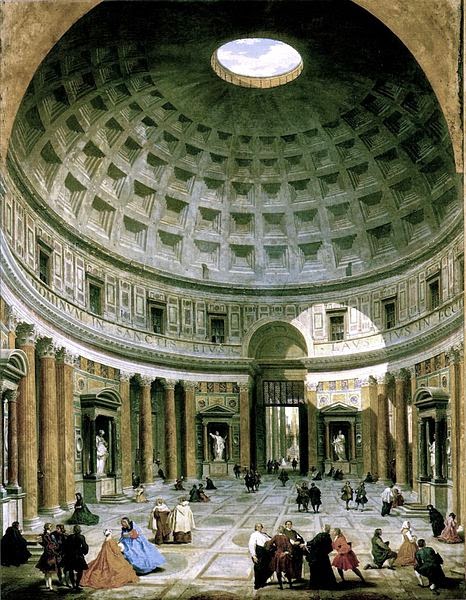A DAY WITH EMPEROR HADRIAN
Rome is so filled with treasures that it is often hard to know where to start. Sometimes it is easier to concentrate on one artist like Caravaggio or architect such as Bernini (who is almost impossible to avoid anyway). The last time we were in the city we decided to give one day to a Roman emperor, Hadrian, who ruled from AD 117 until his death in AD 138.
One of the few emperors who still gets good press as an administrator, he was a great traveler and builder, particularly in Rome. We began with one of the greatest architectural triumphs of all time, the Pantheon. Despite the inscription over the portico saying that it was built by Agrippa, Hadrian oversaw its reconstruction after it was twice nearly totally destroyed by fire.
The concrete dome at 142 feet across is larger than the dome at St. Peters and still the largest ever built of that material. The only light comes from the oculus, a hole in the center of the dome 30 feet in diameter. We stood to one side watching the sunlight slowly make its way across the floor, illuminating clumps of visitors. What would Agrippa, who originally built the temple to commemorate his victory over Antony and Cleopatra, think of all the tourists now enjoying the sight with no interest in the gods he worshipped?

When it was time to move on, we turned in the direction of the Vatican, crossing the beautiful Ponte Sant’Angelo, lined with ten Bernini-designed statues.

The bridge was originally built in the second century AD by Hadrian as an impressive approach to his family mausoleum, now Castle Sant’Angelo. On this sunny day it was lined with fake artists selling prints as originals, and real artists industriously sketching or painting. I think Hadrian would be pleased with the admiration.
The tomb retains its basic round shape despite the centuries of rebuilding. Originally it was surrounded by cypress trees and topped by a bronze 4-horse chariot, driven by Hadrian personifying the sun. The statue was replaced in Christian times by an angel in thanks for relief from a plague. The interior has Renaissance-era canons and cannonballs but is now devoted to art exhibitions rather than defense.
We had lunch on the terrace overlooking St. Peter’s and Rome; instead of thinking about Cleopatra and her lovers we thought about the passageway that leads from the Vatican to the Castle used by Pope Clement VII to escape marauders in 1527. The pope probably ate better food but our view unforgettable, as only Rome can offer.
It was time to leave the heat and crowds for the countryside. Villa Adriana, Hadrian’s country retreat, near the little town of Tivoli in the hills east of Rome was the largest estate in the Roman Empire. Now it is a fascinating collection of ruins comprising the remains of at least thirty residences, baths, theaters, libraries, and stadiums. The park-like setting with olive, cypress and umbrella pine trees is the perfect place to wander on a summer afternoon.
Hadrian began building in AD 118, the year after he became emperor and, amazingly, it was completed in ten years. The architectural styles are a glorious collection of travel souvenirs of his thirty years of travels throughout the empire.
I noticed the modern address of the complex is Largo Marguerite Yourcenar 1, an odd address until I remembered Marguerite Yourcenar is the author of the unforgettable Memoirs of Hadrian, a fictional autobiography “written” by Hadrian dedicated to his grandson, Marcus Aurelius. In further memory of her genius, the small museum at the site was hosting an exhibition dedicated to her life and work. It was appropriately titled “Imagined Antiquity.”
One aspect of Hadrian’s life has caught the attention of a number of authors: his passion for all things Greek, including the youth named Antinous. Within days of the discovery of his body in the murky floodwaters of the Nile where he and Hadrian had been hunting, the emperor founded a cult to immortalize him. The city, Antinopolis, built where the body was discovered, is now just a footnote in detailed guides to Egypt, but many museums including the Vatican have portraits of him as a god or otherwise idealized. His fleshy body, full lips and lush locks are instantly recognizable. Hadrian’s obsession is the subject of another fascinating book, Royston Lambert’s,
Beloved and God.
The Canopus, an area with a reflecting pool bordered by statues, is thought to be the emperor’s memorial to Antinous, and to me is the more evocative area of the complex. I could visualize Hadrian in deep mourning walking beside the waters to put the cares of running the empire aside to dream of what might have been. We should all be so loved!
Photos by Judith Works except for the two statues and the painting which are from Wikipedia Commons.
Painting of the Pantheon is by Giovanni Paolo Panini, 1691-1765
Like this:
Like Loading...
TAGS





